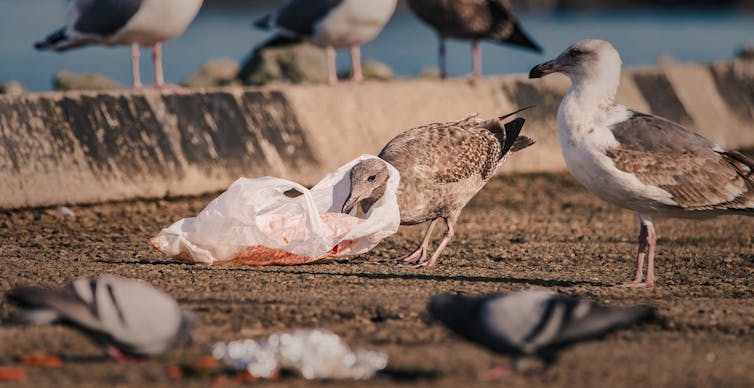If you’ve ever forgotten your bag for life at the shop till and had to buy a plastic bag, you may have wondered where that money goes. The carrier bag levy of five pence (5p) was rolled out on October 5 2015 in England. Retailers are expected to donate the proceeds to good causes that would benefit society and the environment, and to report that information to the government.
We looked at how the scheme has been implemented since then. The regulation was intended to limit the number of people using single-use plastic carrier bags, so that fewer end up as litter around the UK. These bags can also ensnare and choke wildlife and some species mistake them for food. The ensuing levy has succeeded in curtailing single-use plastic bags – according to government figures, plastic bag sales in Britain’s largest supermarkets were down by 80% three years on.

A drop in the ocean
The benefits of the 5p levy are clear, but there’s still the question of where the money goes. The charge isn’t a tax, so the government doesn’t collect it – and can’t dictate where the money goes, so can only recommend shops donate it. While most retailers commit some funds to charitable causes, the amount donated tends to vary.
Every retailer has its own policy for managing the levy and can decide how much of the proceeds from it are donated. Retailers must report what they do with the proceeds from the levy, but not how much. And the publication of information on donations is voluntary. Based on data published by the government for 2017-2018, only around 60% of retailers voluntarily gave information on donations they had made to good causes. There is no way to tell what happened to the remaining 40% – it’s possible that some did not donate at all.
Several stores discourage people from buying 5p carrier bags in favour of more durable but more expensive options that are re-usable, such as “bags for life”. The more expensive bags are usually prominently displayed at checkouts, while the 5p bags are often just out of sight.
Bags for life aren’t “single-use” in the legislation, so the proceeds from their sales don’t have to be donated to charity. In other words, retailers can consider such sales as an additional source of income. While retailers can encourage shoppers to retain and reuse these bags, there is an opportunity for some to profit from their sale to shoppers who buy a new one each time. This suggests that the main beneficiaries of the carrier bag levy in England may well be the retailers themselves.

Very few retailers advise customers that they can get a free replacement for used carrier bags. Customers can bring their old, used carrier bags from a shop and have them exchanged for new ones for free at the same shop. There weren’t signs to convey this to customers in any of the stores that we surveyed. Many shoppers are unaware that they can avoid the 5p charge altogether by exchanging the 5p bags for free when they are worn out. Unfortunately, retailers are doing little to educate their customers on how to recycle the bags.
We found that the more expensive the store, the more likely customers will pay for carrier bags rather than reuse old ones, so reducing the number of carrier bags being bought may depend to a certain extent on the value of the goods. Advertising the bag replacement scheme could have more effect, then, in department stores and places selling more expensive goods.
Read more: The 5p carrier bag charge has paved the way for other waste reduction policies
Prior to the levy, the cost of designing and manufacturing these single-use bags fell directly on the stores, with no profit margin. Now that stores charge customers for single-use bags, the revenue from the sale can provide them with extra resources to invest in the design and quality of reusable bags for life.
We found that the design of these reusable bags has considerably improved since the levy came into effect, with more colourful and eye catching designs that carry the logo and name of sponsors. Customers end up carrying these sponsor messages to a broader audience and are inadvertently acting as brand ambassadors for these stores.
What we found when we dug into the plastic bag levy suggests it has been managed in a way that can confuse customers and leave them unaware of the levy’s purpose or their option to return used bags. If customers believe their 5p is going to good causes but discover it’s actually going into marketing spend for retailers, they may lose confidence in the scheme. The levy has been a remarkable success so far, it would be a shame for it to let down customers through a lack of accountability and transparency.

